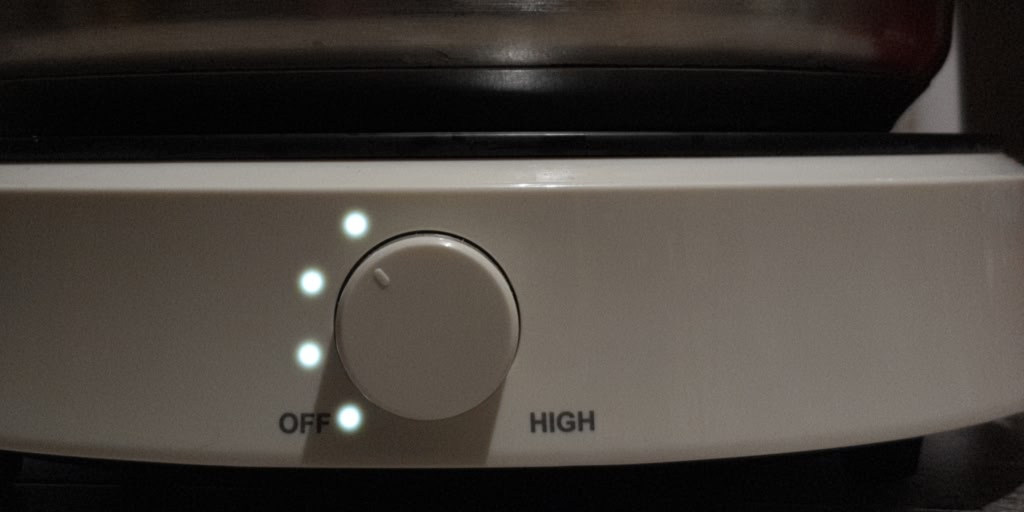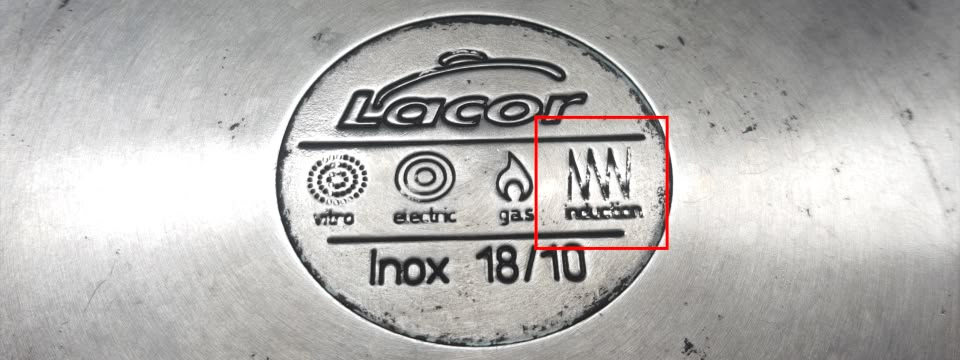Review of Oraimo InstaCooker OIC-201A

The Oraimo InstaCooker OIC-201A is a budget single-burner cooker that uses a changing magnetic field instead of a fire, hot coil, hot plate, invisible light, or visible light to heat the pot or pan.
Because it heats the pot or pan's metal using a changing magnetic field, the pot or pan must strongly attract magnets for it to work correctly. For example, aluminium pots won't work correctly with it.
The 'strongly attracts magnets' requirement is unusual. However, many other types of electric cookers are slow, and in contrast, cookers (like this one) that require a pot or pan that strongly attracts magnets heat as fast as gas.
For example, with this cooker at its highest setting, 3 sachets of water take about 5 minutes and 15 seconds to start boiling well.
Sometimes, infrared cookers are mislabeled as induction. If a picture on a box shows a patterned circular red glow near the centre of a cooker, then it is infrared (visible light is also emitted at higher settings). The Oraimo InstaCooker OIC-201A is an induction (changing magnetic field) cooker, and not an infrared cooker mislabeled as induction.
Observed electricity usage
| Around the knob | Watts | Cost |
|---|---|---|
| 2 lights | 167 | GHS 0.14 or 0.32 or 0.42 / hour |
| 3 lights | 230 | GHS 0.19 or 0.44 or 0.58 / hour |
| 4 lights | 478 | GHS 0.40 or 0.90 or 1.19 / hour |
| 5 lights | 1116 | GHS 0.93 or 2.11 or 2.79 / hour |
| 6 lights | 1300 | GHS 1.09 or 2.46 or 3.25 / hour |
| 7 lights | 1750 | GHS 1.46 or 3.31 or 4.37 / hour |
| 8 lights | 1872 | GHS 1.56 or 3.54 or 4.68 / hour |
| 9 lights | 1928 | GHS 1.61 or 3.65 or 4.82 / hour |
4 lights may maintain boiling, 4–5 lights appear to be suitable for frying, and 3 lights appear to be suitable for porridge.
The cooker's watts and costs aren't constant. A lower voltage should correspond to lower watts and lower costs. The cooker's fan speed changes, but this should change the usage and costs much. A higher coil temperature should correspond to lower watts and lower costs. For the table, the coil temperature was near 'room temperature'.
 An attempt to graph the variations observed while on the highest setting on a different day.
An attempt to graph the variations observed while on the highest setting on a different day.Errors are possible.
Slow PWM
To reduce heating on lower settings, lower settings switch the cooker off for a few seconds, switch the cooker on for a few seconds, switch the cooker off for a few seconds... and this is repeated. It is common on budget induction cookers, and is sometimes called PWM. It appears to be:| Around the knob | On | Off |
|---|---|---|
| 2 lights | For 2 seconds | For 8 seconds |
| 3 lights | For 3 seconds | For 9 seconds |
| 4 lights | For 5 seconds | For 5 seconds |
 Off (one blinking light), then 2 lights, then 3 lights, then 4 lights, then 5 lights.
Off (one blinking light), then 2 lights, then 3 lights, then 4 lights, then 5 lights.Centralised heating
Heating is not uniform but mostly close to the centre. This is common on budget induction cookers. The high-heat diameter appears to be < 13 cm.Other observations
- Water that falls into the gap between the shell and the knob might get into the electronics. The cooker will probably be fine if water falls elsewhere while it's upright. Whether or not there is a seal inside the knob was not determined. Recall that there are LEDs near the knob.
- In case of 'light off' (power outage) occuring while cooking, the pot or pan should not be left on it, because doing so might spoil the cooker. Normally, a built-in fan cools the cooker, but if the power is out, it cannot.
- The plug's earth/ground prong is plastic. However, the cooker's shell might be made of plastic instead of a metal. As for the plug's shape and whatnot, the plug is labelled BS 1363/A SS 145/A.
- The fan inside the cooker might not be loud. There is a beep when the heat setting is changed, and it might be moderately loud.
- There appears to be no timer and no/indirect temperature control.
- The knob is continuous and does not snap.
- The plug appears to not get hot.
Magnets
The pot or pan must strongly attract magnets. Magnets must stick to at least the bottom of the pot or pan. If a magnet doesn't stick, the pot or pan should not be used with this type of stove.However, magnets, like fridge magnets, might be hard to find in the market. Note: any magnets are for checking the pot or pan, and are not to be left on the pot or pan while cooking.
Another potential strategy is to use a phone's compass. There are apps that show magnetometer readings, and at least a part of the bottom of a pot or pan that strongly attracts magnets should substantially affect the values while the phone is very close, even when the phone and pan are not rotated.
Do not rely on the iron content alone. There are iron-containing pots and pans that are not strongly attracted to magnets.

